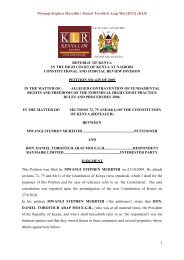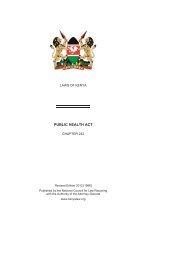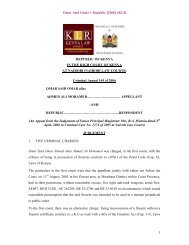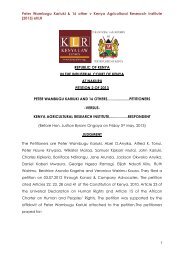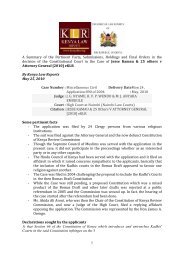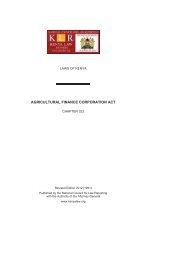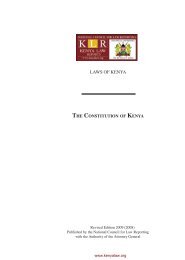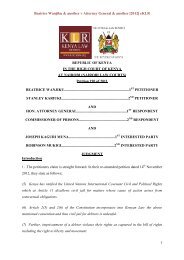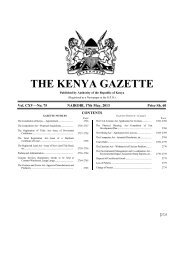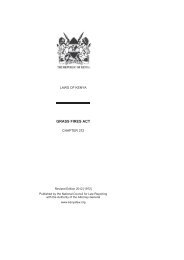Standardization, Quality Assurance, Metrology and Testings
Standardization, Quality Assurance, Metrology and Testings
Standardization, Quality Assurance, Metrology and Testings
You also want an ePaper? Increase the reach of your titles
YUMPU automatically turns print PDFs into web optimized ePapers that Google loves.
<strong>St<strong>and</strong>ardization</strong>, <strong>Quality</strong> <strong>Assurance</strong>, <strong>Metrology</strong> <strong>and</strong> <strong>Testings</strong>THE EAST AFRICAN COMMUNITYDate of assent: 10th September, 2006Date of commencement: 1st August, 2007An Act of the Community to make provision for ensuringst<strong>and</strong>ardisation, quality assurance, metrology <strong>and</strong> testing ofproducts produced or traded in the Community in order tofacilitate industrial development <strong>and</strong> trade; to make provision forensuring the protection of the health <strong>and</strong> safety of society <strong>and</strong> theenvironment in the Community; to establish the East AfricanSt<strong>and</strong>ards Committee <strong>and</strong> the East African Accreditation Board;<strong>and</strong> to provide for related matters.ENACTED by the East African Community <strong>and</strong> assented to by the President ofthe United Republic of Tanzania, the President of the Republic of Kenya <strong>and</strong> thePresident of the Republic of Ug<strong>and</strong>a.1. (1) This Act may be cited as the East AfricanCommunity <strong>St<strong>and</strong>ardization</strong>, <strong>Quality</strong> <strong>Assurance</strong>, <strong>Metrology</strong> <strong>and</strong>Testing Act, 2006.(2) This Act shall come into force on such date as theCouncil may by notice in the Gazette appoint.2. In this Act unless the context otherwise requires—"accreditation" means third-party attestation related toa conformity assessment body conveying formaldemonstration of its competence to carry outspecific conformity assessment tasks;Citation <strong>and</strong>Commencement.Interpretation."Board" means the East African Accreditation Boardestablishment under section 11 of the Act;53
<strong>St<strong>and</strong>ardization</strong>, <strong>Quality</strong> <strong>Assurance</strong>, <strong>Metrology</strong> <strong>and</strong> <strong>Testings</strong>"metrology unit" means the seven Le SystemeInternational d'Unites (SI) base units, namely themetre kilogram second, ampere, Kelvin, mole <strong>and</strong>c<strong>and</strong>ela or any SI derived unit expressed in termsof the SI base units <strong>and</strong> supplementary units;"metrology" means science of measurements <strong>and</strong>includes scientific, industial <strong>and</strong> legal metrology;"national focal point: means a Partner State liaisonoffice that h<strong>and</strong>les or coordinates an element ofconformity assessment in the absence of anational accreditation body;"normative document" means a document developed <strong>and</strong>approved by the Committee, that resembles an EastAfrican St<strong>and</strong>ard, but which for reasons of urgency,cost, or expediency, has not achieved the samedegree of consensus as an East African St<strong>and</strong>ard;"Partner States" means the United Republic of Tanzania,the Republic of Kenya, the Republic of Ug<strong>and</strong>a <strong>and</strong>any other country granted membership to theCommunity under Article 3 of the Treaty;"person: means a natural or legal person;"product" means goods <strong>and</strong> services designed to bereleased or launched in a market;"quality assurance" means that part of the coordinatedactivities to direct <strong>and</strong> control an organizationwith regard to quality, focused on providingconfidence that quality requirements shall befulfilled;"quality system" means the totality of policy, legal,infrastructure <strong>and</strong> institutional arrangements thatprovide support <strong>and</strong> services in st<strong>and</strong>ards,metrology, testing, certification <strong>and</strong> accreditationin both the regulatory <strong>and</strong> non-regulatory domain;56
<strong>St<strong>and</strong>ardization</strong>, <strong>Quality</strong> <strong>Assurance</strong>, <strong>Metrology</strong> <strong>and</strong> <strong>Testings</strong>"reference material" means material or substance oneor more of whose property values are sufficientlyhomogeneous <strong>and</strong> well established to be used forcalibration of an apparatus, the assessment of ameasurement method, or for assigning values tomaterials;"secretariat" means the Secretariat established by asdefined in the Treaty;"st<strong>and</strong>ard" means a document approved by a recognizedbody that provides for common <strong>and</strong> repeated use,rules, guidelines or characteristics of products <strong>and</strong>their related processes or production methods, withwhich compliance is not m<strong>and</strong>atory <strong>and</strong> may coverterminology, symbols, packaging, marking orlabeling requirements as they apply to a process orproduction method;"st<strong>and</strong>ardization" means the activity of establishing,with regard to actual or potential problems,provisions for common <strong>and</strong> repeated us, aimed atachievement of optimum degree of order in agiven context;"summit" means the Summit of Heads of State of theEast African Community established by Article 9of the Treaty;"technical regulation" means a document that laysdown product characteristics or their relatedprocesses or production methods, includingadministrative provisions, with which complianceis m<strong>and</strong>atory <strong>and</strong> may cover terminology,symbols, packaging, marking or labelingrequirements as they apply to a product, processor production method;"testing" means determination of one or morecharacteristics of <strong>and</strong> object of conformityassessment, according to a procedure;57
<strong>St<strong>and</strong>ardization</strong>, <strong>Quality</strong> <strong>Assurance</strong>, <strong>Metrology</strong> <strong>and</strong> <strong>Testings</strong>4. (1) There is established a Committee to be known as theEast AfricanSt<strong>and</strong>ardsEast African st<strong>and</strong>ards Committee.Committee.(2) The functions of the Committee shall be to—(a)(b)(c)(d)(e)(f)undertake <strong>and</strong> coordinate activities related tost<strong>and</strong>ardization, metology <strong>and</strong> conformityassessment;develop <strong>and</strong> establish frameworks that advancecompliance by the Partner States with theirobligations under this Act;set out priorities <strong>and</strong> prepare implementationprogrammes with regard to st<strong>and</strong>ardization,metrology <strong>and</strong> conformity assessment activities atnational <strong>and</strong> Community levels consistent withthe provisions of the Act;monitor <strong>and</strong> keep under constant review theimplementation of the st<strong>and</strong>ardization, metrology<strong>and</strong> conformity assessment programmes atnational <strong>and</strong> Community levels;submit st<strong>and</strong>ards, reports <strong>and</strong> recommendationsto the Council on its own intiative or upon requestof the council concerning the implementation ofthe Treaty that affect st<strong>and</strong>ardization, metrology<strong>and</strong> conformity assessment;establish procedures for the development,approval, gazetting <strong>and</strong> withdrawal ofharmonised East African St<strong>and</strong>ards including theadoption of these st<strong>and</strong>ards at the national levels;establish liaison mechanisms with other regional<strong>and</strong> international organizations consistent withthe objects of this Act;monitor <strong>and</strong> keep under constant review theeffectiveness of the national WTO TBTAgreement enquiry points; <strong>and</strong>hear appeals with regard to administrativemeasures for Compulsory St<strong>and</strong>ards implementedin the Partner States;59
<strong>St<strong>and</strong>ardization</strong>, <strong>Quality</strong> <strong>Assurance</strong>, <strong>Metrology</strong> <strong>and</strong> <strong>Testings</strong>(j)perform other functions consistent with theobjects of this Act, or as directed by Council.(3) In carrying out its functions, the Committee shallhave due regard for the requirements <strong>and</strong> obligations of the WTOTBT Agreement.(4) The Committee shall comprise—(a)(b)(c)two chief executives from the national qualitysystem institutions designated under section 6 (1)(a), (b) <strong>and</strong> (c), from each Partner State;one representative of private sector testinglaboratories <strong>and</strong> certification organizations fromeach Partner State; <strong>and</strong>two representatives of national manufacturingassociations, trading associations <strong>and</strong> consumerorganizations from each Partner State.(5) The Committee, may establish subcommittees toassist it in its operation.(6) The Committee, in executing its responsibilities,shall liaise with regulatory authorities in the Partner States.(7) The Committee shall—(a)(b)(c)(d)meat at least once every year <strong>and</strong> may holdextraordinary meetings at the request of anyPartner State;be chaired in rotation among the Partner States,corresponding to the tenure of the Summit;take decisions by consensus; <strong>and</strong>determine its own procedures.Establish- 5. (1) There is established a liaison office to providement <strong>and</strong>administrative support to the Committee.Functions ofthe LiaisonOffice.60
<strong>St<strong>and</strong>ardization</strong>, <strong>Quality</strong> <strong>Assurance</strong>, <strong>Metrology</strong> <strong>and</strong> <strong>Testings</strong>(2) The functions of the liaison office shall be to—(a)(b)(c)(d)(e)(f)(g)(h)(i)(j)facilitate <strong>and</strong> provide logistical support for theCommittee <strong>and</strong> the Board;provide input into the deliberations of theCommittee in establishing priority areas forst<strong>and</strong>ardization, metrology <strong>and</strong> conformityassessment programmes at national <strong>and</strong>Community levels;provide logistical support to the Committee in thedesign <strong>and</strong> management of Community projectsfor the implementation of st<strong>and</strong>ardizationmetrology <strong>and</strong> conformity assessment activities;arrange for public review of draft East AfricanSt<strong>and</strong>ards to solicit for comments by interestedparties;arrange for the presentation of draft East AfricanSt<strong>and</strong>ards to the Council for declaration as EastAfrican St<strong>and</strong>ards <strong>and</strong> for the gazetting of theSt<strong>and</strong>ards;maintain the catalogue <strong>and</strong> authoritative text ofthe declared East African St<strong>and</strong>ards;coordinate <strong>and</strong> provide regional <strong>and</strong> internationalnotification regarding East African St<strong>and</strong>ards;facilitate responses to enquiries with respect tost<strong>and</strong>ards <strong>and</strong> technical regulations;facilitate the liaison of regional st<strong>and</strong>ardization,metrology <strong>and</strong> conformity assessment activitiesto other relevant sub-regional, regional <strong>and</strong>international activities;identify training needs <strong>and</strong> areas for capacitybuilding in st<strong>and</strong>ardization, metrology <strong>and</strong>conformity assessment for the Committee;61
<strong>St<strong>and</strong>ardization</strong>, <strong>Quality</strong> Assnaince, Morologv <strong>and</strong> 1(''.stings(k)publicise <strong>and</strong> promote st<strong>and</strong>ardization, metrology<strong>and</strong> conformity assessment activities:(1) coordinate the activities of the Committee;(m)(n)(o)(p)report to the Committee on the implementation ofdecisions of the Council related to st<strong>and</strong>ardization,metrology <strong>and</strong> conformity assessment;prepare budgets <strong>and</strong> work plans of theCommittee;perform any other activity requested by theCommittee; <strong>and</strong>perform other function consistent with the objectsof this Act.Designationof NationalInstitutions.6. (1) Each Partner State shall designate a national qualitysystem institution to function as—(a)(b)(c)(d)a national st<strong>and</strong>ards body;a national metrology institutea national legal metrology department; <strong>and</strong>a national accreditation body.(2) An institution designated under subsection (1) maybe a single institution combining a number of responsibilities, ortwo or more institutions each with its own designatedresponsibilities.(3) A designated institution shall on request provideinformation to another designated institution in respect ofst<strong>and</strong>ardisation, metrology <strong>and</strong> conformity assessment.NationalSt<strong>and</strong>ardsBodies.7. (1) A national st<strong>and</strong>ards body designated under section6(1) (a) shall—(a) develop <strong>and</strong> publish national st<strong>and</strong>ards in linewith internationally recognized procedures;62
<strong>St<strong>and</strong>ardization</strong>, <strong>Quality</strong> <strong>Assurance</strong>, <strong>Metrology</strong> <strong>and</strong> <strong>Testings</strong>(b)(c)(d)(e)(f)liaise with relevant regional <strong>and</strong> internationalorganizations with the similar objectives;give effect to the decisions <strong>and</strong> recommendationsof the Council <strong>and</strong> the Committee with regard toEast African St<strong>and</strong>ards;promote <strong>and</strong> facilitate the use of st<strong>and</strong>ards as thebasis for the development of technical regulations;provide st<strong>and</strong>ards <strong>and</strong> st<strong>and</strong>ard relatedinformation to the public <strong>and</strong> private sectors; <strong>and</strong>promote the concept of st<strong>and</strong>ardization in general.(2) A national st<strong>and</strong>ards body shall represent orcoordinate representation of the Partner State on—(a) relevant regional <strong>and</strong> internationalst<strong>and</strong>ardization organizations such as the AfricanRegional St<strong>and</strong>ards Organization (ARSO), theInternational Organization for <strong>St<strong>and</strong>ardization</strong>(ISO); the International Electro-technicalCommission (IEC); <strong>and</strong>(b)the Committee8. (1) A national metrology institute designated undersection 6 (1) (b) shall—National<strong>Metrology</strong>Institutes.(a)(b)(c)realise, maintain <strong>and</strong> act as custodian of thenational measurement st<strong>and</strong>ards according to theneeds of the private <strong>and</strong> public sectors <strong>and</strong> inaccordance with international st<strong>and</strong>ards;disseminate units of measurement <strong>and</strong> maintain atraceability chain;ensure that the national measurement capabilitiesare appropriately tied to the international mutualrecognition arrangement on measurementcapability;63
<strong>St<strong>and</strong>ardization</strong>, <strong>Quality</strong> <strong>Assurance</strong>, <strong>Metrology</strong> <strong>and</strong> <strong>Testings</strong>(d) liaise with region al <strong>and</strong> internationalorganizations with the similar objectives;(e) give effect to the decisions <strong>and</strong> recommendationsof the Council <strong>and</strong> the Committee with regard tometrology;(f)(g)provide information on metrology to the public<strong>and</strong> private sector; <strong>and</strong>promote the concept of metrology in general.(2) A national metrology institute shall represent orcoordinate representation of the Partner State on—(a)(b)(c)relevant regional <strong>and</strong> international metrologyorganizations, such as the Bureau International dePoids et Mesures (BIPM);the International Committee of weights <strong>and</strong>measures (CIPM) Mutual RecognitionArrangement; <strong>and</strong>the Committee.NationalLegal<strong>Metrology</strong>Departments.9. (1) A national legal metrology department designatedunder section 6 (1)(c) shall—(a)protect society form the consequences of falsemeasurements in public <strong>and</strong> private transactionsin the work environment <strong>and</strong> the health <strong>and</strong> safetysectors;(b)(c)(d)approve or ensure approval by another designatedinstitution, measuring equipment to be used for apublic or private transaction in the workenvironment <strong>and</strong> the health <strong>and</strong> safety sectors;control the use of measuring equipment in public<strong>and</strong> private transactions;control the use of measuring equipment in thework environment <strong>and</strong> the health <strong>and</strong> safetysectors;64
<strong>St<strong>and</strong>ardization</strong>, <strong>Quality</strong> <strong>Assurance</strong>, <strong>Metrology</strong> <strong>and</strong> <strong>Testings</strong>(e)(f)(g)(h)(i)(j)(k)control pre-packaging of products;liaise with regional <strong>and</strong> international organizationswith similar objectives;give effect to the decisions <strong>and</strong> recommendationsof the Council <strong>and</strong> the Committee with regard tolegal metrology;provide information on legal metrology to theprivate <strong>and</strong> public sectors;promote the concept of legal metrology ingeneral;ensure that legal metrology measurementst<strong>and</strong>ards are traceable to national measurementst<strong>and</strong>ards; <strong>and</strong>perform other functions consistent with theobjects of this Act.(2) A national legal metrology department shallrepresent or coordinate representation of the Partner State on—(a)(b)(c)relevant regional <strong>and</strong> international legalmetrology organizations, such as theOrganization Internationale de Metrologie Legale(OIML);the International Committee of Weights <strong>and</strong>Measures (CIPM) Mutual RecognitionArrangement; <strong>and</strong>the Committee.10. (1) A national accreditation body designated undersection 6(1)(d) shall—(a)accredit conformity assessment bodies <strong>and</strong>personnel within a Partner State;NationalAccreditationBodies.(b)monitor international activities relevant to its ownactivities;65
<strong>St<strong>and</strong>ardization</strong>, <strong>Quality</strong> <strong>Assurance</strong>, <strong>Metrology</strong> <strong>and</strong> <strong>Testings</strong>(c)(d)(e)(f)represent the Partner State on the relevantregional <strong>and</strong> international accreditation bodies;enter into agreements on mutual recognition withregional <strong>and</strong> international accreditation bodies;give effect to the decisions of the Board <strong>and</strong> theCouncil; <strong>and</strong>promote the concept of accreditation in general.(2) A national accreditation body designated undersection 6(1) (d) shall be recognized by the Partner Statesprovided that the body demonstrates that it is pursuinginternational recognition or is internationally recognized by theInternational Accreditation Form.East AfricanAccreditationBoard.11. (1) There is established board to be known as the EastAfrica accreditation Broad.(2) The Board shall comprise the chief executives of thenational accreditation bodies <strong>and</strong> the national focal points.(3) The functions of the Board shall be to—(a) facilitate cooperation <strong>and</strong> coordinateaccreditation activities to avoid duplication offunctions of the national accreditation bodies <strong>and</strong>national focal points;(b)(c)facilitate accreditation of conformity assessmentservice providers within the Partner States; <strong>and</strong>promote the acceptability of test, certification <strong>and</strong>inspection results from accredited organizationswithin the Community.(4) The Board shall—(a) meet at least once every year, <strong>and</strong> may holdextraordinary meetings at the request of anyPartner State;66
<strong>St<strong>and</strong>ardization</strong>, <strong>Quality</strong> <strong>Assurance</strong>, <strong>Metrology</strong> <strong>and</strong> <strong>Testings</strong>(b)(c)(d)be chaired in rotation among the Partner States,corresponding to the tenure of the Summit;take decisions by consensus; <strong>and</strong>determine its own procedures.12. (1) Partner States may establish or designateorganizations to function as test laboratories to provide scientific<strong>and</strong> technical services.TestLaboratories.(2) Where a test laboratory is established or designatedunder section 12 (1), it shall—(a)(b)(c)(d)(e)(f)supply information on analysis methods <strong>and</strong>comparative testing to other laboratories;co-ordinate the development of new analyticalmethods;organize <strong>and</strong> participate in inter-laboratorycomparisons <strong>and</strong> proficiency testing schemesbetween various national, regional <strong>and</strong>international laboratories;ensure that certified reference materials instrategic areas, for quality control are available;ensure that adequate <strong>and</strong> competent staff isavailable; <strong>and</strong>pursue accreditation.(3) Partner States shall ensure that test laboratoriesestablished or designated under section 12(1)—(a)(b)(c)have qualified staff with sufficient knowledge ofthe relevant techniques;have sufficient resources for carrying out therelevant tasks;have suitable infrastructure to enable them toperform the required tests; <strong>and</strong>67
<strong>St<strong>and</strong>ardization</strong>, <strong>Quality</strong> <strong>Assurance</strong>, <strong>Metrology</strong> <strong>and</strong> <strong>Testings</strong>(d) operate quality management systems inaccordance with the relevant internationalst<strong>and</strong>ards.(4) Where a designated test laboratory of a PartnerStates is accredited, the other Partner States shall accept the testresults <strong>and</strong> test reports of that test laboratory.(5) Where a designated test laboratory of a Partner Stateis not accredited, the other Partner States may accept the testresults <strong>and</strong> test reports from that laboratory by agreement.DevelopmeatofEast AfricanSt<strong>and</strong>ards.Declarationof EastAfricanSt<strong>and</strong>ards.13. (1) An East African St<strong>and</strong>ard shall be developmentjointly by the national st<strong>and</strong>ards bodies of the Partner States.(2) An East African St<strong>and</strong>ard shall be development inaccordance with procedure approved, published <strong>and</strong> maintainedby the Committee.14. (1) The Council may by notice in the Gazette declare ast<strong>and</strong>ard for any product or for the manufacture, production,processing, treatment or performance of any product, or for anyprocess, installation construction, testing, operation or use of anyarticle or device to be an East African St<strong>and</strong>ard.(2) The Council may amend or withdraw an EastAfrican St<strong>and</strong>ard.(3) The Council shall before declaring an East AfricanSt<strong>and</strong>ard ensure that—(a)(b)the st<strong>and</strong>ard is set or amended in accordance withprocedures developed, published <strong>and</strong> maintainedby the Committee; <strong>and</strong>the interests of all relevant parties, including themanufacturer, supplier <strong>and</strong> consumer areconsidered.(4) Only a st<strong>and</strong>ard declared by the Council shall becalled <strong>and</strong> East African St<strong>and</strong>ard.68
<strong>St<strong>and</strong>ardization</strong>, <strong>Quality</strong> <strong>Assurance</strong>, <strong>Metrology</strong> <strong>and</strong> <strong>Testings</strong>(5) A declaration or amendment of an East AfricanSt<strong>and</strong>ard shall be sufficient where the Gazette notice states thetitle <strong>and</strong> number of the st<strong>and</strong>ard.15. (1) Within six months of the declaration of an EastAfrican St<strong>and</strong>ard, the Partner States shall adopt, withoutdeviation from the approved text of the st<strong>and</strong>ard, the East AfricanSt<strong>and</strong>ard as a national st<strong>and</strong>ard <strong>and</strong> withdraw any existingnational st<strong>and</strong>ard with similar scope <strong>and</strong> purpose.(2) The national st<strong>and</strong>ards bodies of the Partner Statesshall publish the text of the adopted East African St<strong>and</strong>ard as anational st<strong>and</strong>ard in accordance with ISO/IEC Directives.16. (1) The Committee may develop <strong>and</strong> approve anormative document to serve as an East African St<strong>and</strong>ard.Adoption ofEast AfricanSt<strong>and</strong>ardsby PartnerStates.Normativedocuments.(2) For purposes of urgency, a normative document shallbe developed in place of an East African St<strong>and</strong>ard.(3) A normative document shall be valid for a period oftwo years from the date of approval by the Committee.(4) The committee shall publish guidelines for thecompilation <strong>and</strong> publication of normative documents.(5) The normative documents shall be published by thenational st<strong>and</strong>ards bodies of the Partner States in a manner thatdistinguishes them from East African St<strong>and</strong>ards.Catalogue17. (1) The Secretariat shall maintain a catalogue of East<strong>and</strong>African St<strong>and</strong>ards <strong>and</strong> normative documents.authoritativetext of EastAfrican(2) The catalogue shall be made available to the public St<strong>and</strong>ards.by the Secretariat in such format as the Council may direct.(3) The catalogue shall include—(a)(b)the title <strong>and</strong> number of the East African St<strong>and</strong>ardor normative document; <strong>and</strong>a summary of the scope <strong>and</strong> purpose of that EastAfrican St<strong>and</strong>ard or normative document.69
<strong>St<strong>and</strong>ardization</strong>, <strong>Quality</strong> <strong>Assurance</strong>, <strong>Metrology</strong> <strong>and</strong> <strong>Testings</strong>(4) The Secretariat shall maintain the authoritative textof each East African St<strong>and</strong>ard an normative document in hardcopy <strong>and</strong> electronic format, in a manner that ensures the integrityof the text.Copyright<strong>and</strong>publicationof EastAfricanSt<strong>and</strong>ards.18. (1) Not with st<strong>and</strong>ing any other law—(a)the copyright in any East African St<strong>and</strong>ard orother normative documents shall vest in thenational st<strong>and</strong>ards bodies of the Partner States; <strong>and</strong>(b)the national st<strong>and</strong>ards bodies of the Partner Statesshall not be deprived of a copyright in paragraph(a) where a st<strong>and</strong>ard or a provision of the st<strong>and</strong>ardis incorporated in a law in terms of the provisionsof any law.(2) A person shall not without the authorization of anational st<strong>and</strong>ards body of a Partner State; publish, reproducerecord of transmit any document or any part of a document inrespect of which a copyright vests under subsection (1),Declaration,Publication<strong>and</strong>Implementation ofCompulsorySt<strong>and</strong>ards.19. (1) The Council on the recommendation of theCommittee <strong>and</strong> subject to the expiry period in subsection 6 (d)may declare an East African St<strong>and</strong>ard or a provision of thatst<strong>and</strong>ard to be a compulsory st<strong>and</strong>ard throughout the Community.(2) The declaration of a compulsory st<strong>and</strong>ard shall be to—(a)(b)(c)(d)prevent deceptive practices;protect human health <strong>and</strong> safety;protect animal or plant life or health; <strong>and</strong>protect the environment(3) The Council on the recommendation of theCommittee may amend or withdraw a compulsory st<strong>and</strong>ard.(4) The Committee shall when recommending to theCouncil that an East African St<strong>and</strong>ard be declared a compulsoryst<strong>and</strong>ard, ensure, that-70
<strong>St<strong>and</strong>ardization</strong>, <strong>Quality</strong> <strong>Assurance</strong>, <strong>Metrology</strong> <strong>and</strong> <strong>Testings</strong>(a)(b)(c)(d)(e)the problem to be solved is precisely stated;the intervention is based on clear evidence thatgovernment action is justified;it is not practicable to achieve the purpose of thest<strong>and</strong>ard other than by declaring it a compulsoryst<strong>and</strong>ard;the required legislation <strong>and</strong> infrastructure toenforce the compulsory st<strong>and</strong>ard in the PartnerStates are in place; <strong>and</strong>appropriate notification under the WTO TBTAgreement has been forwarded to the WTOSecretariat.(5) The Council shall, before declaring an East AfricanSt<strong>and</strong>ard a compulsory st<strong>and</strong>ard publish in the Gazette <strong>and</strong> in atleast one newspaper of national circulation in each Partner State,a notice of its intention to declare a compulsory st<strong>and</strong>ard.(6) The notice under subsection (5) shall—(a)(b)(c)(d)contain the number <strong>and</strong> title of the East AfricanSt<strong>and</strong>ard;state the reason for declaring it a compulsoryst<strong>and</strong>ard;contain the addresses where the complete text ofthe East African St<strong>and</strong>ard may be viewed orobtained from; <strong>and</strong>invite objections from any interested person to belodged with the Council, within sixty days in amanner as the Council may specify in the notice.(7) The Council shall not declare an East AfricanSt<strong>and</strong>ard a compulsory st<strong>and</strong>ard, unless all persons who lodgedobjections under subsection 6(d) have been given an opportunityto be heard.71
<strong>St<strong>and</strong>ardization</strong>, <strong>Quality</strong> <strong>Assurance</strong>, <strong>Metrology</strong> <strong>and</strong> <strong>Testings</strong>(8) Upon declaration of a compulsory st<strong>and</strong>ard, theCouncil shall publish a notice in the Gazette to that effect.(9) The notice of the compulsory st<strong>and</strong>ard in the Gazetteshall contain—(a)(b)the number <strong>and</strong> title of the compulsory st<strong>and</strong>ard;<strong>and</strong>the proposed date of implementation of thest<strong>and</strong>ard.(10) Within three months of the declaration of acompulsory st<strong>and</strong>ard, each Partner State shall ensure that thecompulsory st<strong>and</strong>ard is implemented in its territory.(11) The Partner States shall approximate their conformity assessment modalities applicable for demonstratingcompliance with compulsory st<strong>and</strong>ards.(12) A product within the scope of a compulsoryst<strong>and</strong>ard which is approved by a public regulatory authority of aPartner State appointed under section 21 shall be accepted by thepublic regulatory authorities of the other Partner States withoutimposition of any additional requirements.(13) Subsection (12) shall only apply after the PartnerStates approximate their conformity assessment modalities asrequired under subsection (11).RegulatoryAuthoritiesin PartnerStates.20. (1) Each Partner State shall appoint public regulatoryauthorities to administer compulsory st<strong>and</strong>ards.(2) Each Partner State shall notify the Secretariat <strong>and</strong>the Partner States of the public regulatory authorities appointedunder subsection (1).(3) The Partner States shall ensure that the publicregulatory authorities—(a)(b)administer the compulsory st<strong>and</strong>ards;monitor <strong>and</strong> take measures to ensure compliancewith the compulsory st<strong>and</strong>ards;72
<strong>St<strong>and</strong>ardization</strong>, <strong>Quality</strong> <strong>Assurance</strong>, <strong>Metrology</strong> <strong>and</strong> <strong>Testings</strong>(c)(d)(e)(f)(g)grant approval for the manufacture of products,operation of processes <strong>and</strong> rendering of servi^:,to which a compulsory st<strong>and</strong>ard applies, whenrequired;grant approval for trading, distribution, selling orbringing into circulation products <strong>and</strong> renderingof services to which a compulsory st<strong>and</strong>ardapplies, when required;apply sanctions in cases of non compliance withthe compulsory st<strong>and</strong>ards;collect fees <strong>and</strong> levies payable in respect ofproducts, <strong>and</strong> processes to which a compulsoryst<strong>and</strong>ard applies; <strong>and</strong>make recommendations to the Committee on thepublication, amendment <strong>and</strong> withdrawal ofparticular compulsory st<strong>and</strong>ards.21. (1) Each Partner State shall register technically competentnational conformity assessment service providers includinginspection agencies, test laboratories <strong>and</strong> certification organizationsto provide services in support of the implementation of compulsoryst<strong>and</strong>ards in its territory, <strong>and</strong> shall notify the Secretariat <strong>and</strong> theother Partner States accodingly.ConformityAssessmentProvidersforCompulsorySt<strong>and</strong>ards.(2) A national conformity assessment service providermay be a person or a private or a public entity registered underthe laws of the Partner State.(3) A national conformity assessment service providerthat loses its technical competency or fails to conform to anylegal requirements shall be suspended <strong>and</strong> where the serviceprovider does not regain its technical competence or comply withlegal requirements within a period of six months from the date ofsuspension, it shall be deregistered by the Partner State.(4) Suppliers of products <strong>and</strong> processes shall procureconformity assessment services in compliance with compulsoryst<strong>and</strong>ards, from registered national conformity assessmentservice providers or from accepted foreign conformityassessment service providers.73
<strong>St<strong>and</strong>ardization</strong>, <strong>Quality</strong> <strong>Assurance</strong>, <strong>Metrology</strong> <strong>and</strong> <strong>Testings</strong>(5) A Partner State shall notify the other Partner Statesof its intention to accept conformity assessment results fromforeign conformity assessment service providers in theadministration of specific compulsory st<strong>and</strong>ards <strong>and</strong> the basis forthis acceptance.(6) A foreign conformity assessment service providershall be a person or a private or a public entity registered as suchunder the laws of a foreign country.(7) Each Partner State shall maintain a register of allnational <strong>and</strong> foreign conformity assessment service providers<strong>and</strong> make it accessible to the public.(8) Each Partner State shall ensure that its regulatoryauthorities accept as far as is practicable, inspection results, testresults <strong>and</strong> certifiction from conformity assessment serviceproviders notified by the other Partner States.EnforcementofCompulsorySt<strong>and</strong>ards.22. (1) No person shall manufacture, trade distribute, sell,supply or bring a product that is within the scope of acompulsory, st<strong>and</strong>ard into the Community unless the productconforms to the requirements of the compulsory st<strong>and</strong>ard.(2) The Partner States shall ensure that their publicregulatory authorities suspend the manufacture, tradingdistribution or sale of products that do not conform tocompulsory st<strong>and</strong>ards.(3) Where products already on the market do notcomply with the compulsory st<strong>and</strong>ards, the regulatory authorityshall—(a)(b)(c)order the importer of supplier of the product toremove the product from the market;order the importer of the product to return it to thecountry of origin; <strong>and</strong>confiscate <strong>and</strong> destroy the product.74
<strong>St<strong>and</strong>ardization</strong>, <strong>Quality</strong> <strong>Assurance</strong>, <strong>Metrology</strong> <strong>and</strong> <strong>Testings</strong>(4) In addition to the powers in subsections (2) <strong>and</strong> (3),the Partner States shall apply their national legislation in theenforcement of compulsory st<strong>and</strong>ards.(5) Any person aggrieved by a decision or order underthis section may within fourteen days of the decision or orderappeal to the Committee.(6) An appeal to the Committee shall be dealt withwithin forty five days of the appeal being lodged.(7) During the hearing of the appeal, the manufacture,trade, distribution, sale or circulation of the product that does notconform to compulsory st<strong>and</strong>ards shall remain suspended.23. (1) Where a Partner State intends to develop <strong>and</strong>implement a national technical regulation relating to a productthat does not fall within the scope of a compulsory st<strong>and</strong>ard, thePartner States shall notify the Secretariat <strong>and</strong> the other partnerState of the National technical regulation at least sixty daysbefore the national technical regulation comes into force.NationalTechnicalRegulations.(2) Partner States shall where practicable base theirnational technical regulations on East African St<strong>and</strong>ards, wherethese exist, in order to, where necessiry, lead to the declarationof the technical regulations as compulsory st<strong>and</strong>ards.24. (1) Each Partner State shall notify the Council of theproduct certification marks within the jurisdiction of the PartnerState including the design of the marks.(2) Partner States shall recognise as equal to their own,product certification marks awarded by national quality systeminstitutions of other Partner States provided that which theadministrative provisions with control the use of the marks meetthe obligations in this section.Declaration<strong>and</strong>Acceptanceof ProductCertificationMarks.(3) Partner States shall ensure that the administrativeprovisions relating to the use of product certification marks meetthe following requirements-75
<strong>St<strong>and</strong>ardization</strong>, <strong>Quality</strong> <strong>Assurance</strong>, <strong>Metrology</strong> <strong>and</strong> <strong>Testings</strong>(a)product certification marks are established <strong>and</strong>appropriately registered to confer protectionsimilar to trademarks;(b)(c)(d)product certification marks are not identical to orso nearly resemble any trade mark registeredunder the trade mark law of a Partner State;no person is allowed to apply a product certificationmark specified under paragraph (a), of thissubsection to any product or label attached to anyproduct except under a permit issued by a nationalquality systems institution <strong>and</strong> unless that productcomplies with the relevant st<strong>and</strong>ard; <strong>and</strong>pre-award testing <strong>and</strong> quality assurancerequirements, post-award surveillance, applicationof the mark <strong>and</strong> offences <strong>and</strong> penalties between thePartner States are approximated to ensure similarityin awarding certification marks in order to fostermutual recognition of the product certificationmarks <strong>and</strong> acceptance by the consumers.Offences.25. Partner States shall enact or amend <strong>and</strong> approximatetheir national laws to provide penalties for the following offences—(a)(b)(c)statements or representations made, that conveythe impression that a product meets therequirements of a st<strong>and</strong>ard where does not;statements or representation made, that conveythe impression that a product carries the productcertification mark where it does not; <strong>and</strong>continuous use of a product certification markwhere the permit for the use is revoked or expired.DisputesbetweenPartnerStates.26. (1) Any Partner State whose interests have not beenappropriately recognised by the Committee in the—(a) development of an East African St<strong>and</strong>ard;76
<strong>St<strong>and</strong>ardization</strong>, <strong>Quality</strong> <strong>Assurance</strong>, <strong>Metrology</strong> <strong>and</strong> <strong>Testings</strong>(b)(c)establishment <strong>and</strong> application of rules <strong>and</strong>procedures of the Committee; ordevelopment <strong>and</strong> implementation of metrology,legal metrology, testing, certification oraccreditation systems,may appeal to the Council in writing no later than sixty days orthe relevant decision of the Committee.(2) Any dispute between the Partner States regarding—(a)(b)the use of st<strong>and</strong>ards to restrict access of productsinto the other Partner States market; ordeliberate <strong>and</strong> wilful neglect by a Partner State toensure compliance with st<strong>and</strong>ards within itsjurisdiction to the detriment of the other PartnerStates, shall be referred to the Council fordetermination.(3) Where a Partner State fails to meet its obligationsunder this Act, any of the other Partner States may appeal to theCouncil in writing to have the matter resolved.(4) Where the Council fails to resolve a matter referredto it the matter shall be referred to the East African Court ofJustice.27. The Partner States shall approximate their national lawson st<strong>and</strong>ardisation, quality assurance, metrology, legalmetrology, testing <strong>and</strong> accreditation <strong>and</strong> align them with this Act.28. (1) The Council may make, amend or revoke regulationsgenerally for giving effect to the provisions of this Act.Approximation<strong>and</strong>Alignmentof NationalLaws.Regulations.(2) Without prejudice to the generality of subsection (1),the Council shall make regulations providing for—(a) the conduct of st<strong>and</strong>ardisation, metrology <strong>and</strong>conformity assessment;77
<strong>St<strong>and</strong>ardization</strong>, <strong>Quality</strong> <strong>Assurance</strong>, <strong>Metrology</strong> <strong>and</strong> <strong>Testings</strong>(b)(c)(d)ensuring adequate support for st<strong>and</strong>ardization,metrology <strong>and</strong> conformity assessment activities;the forms that may be required under theprovisions of this Act; <strong>and</strong>the fees to be paid under this Act.78



